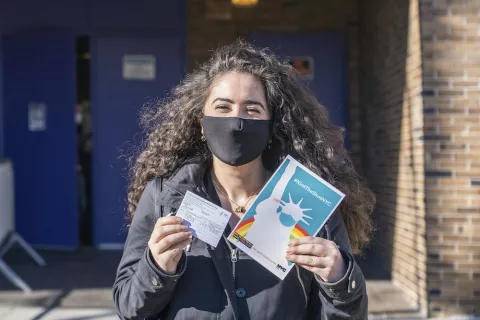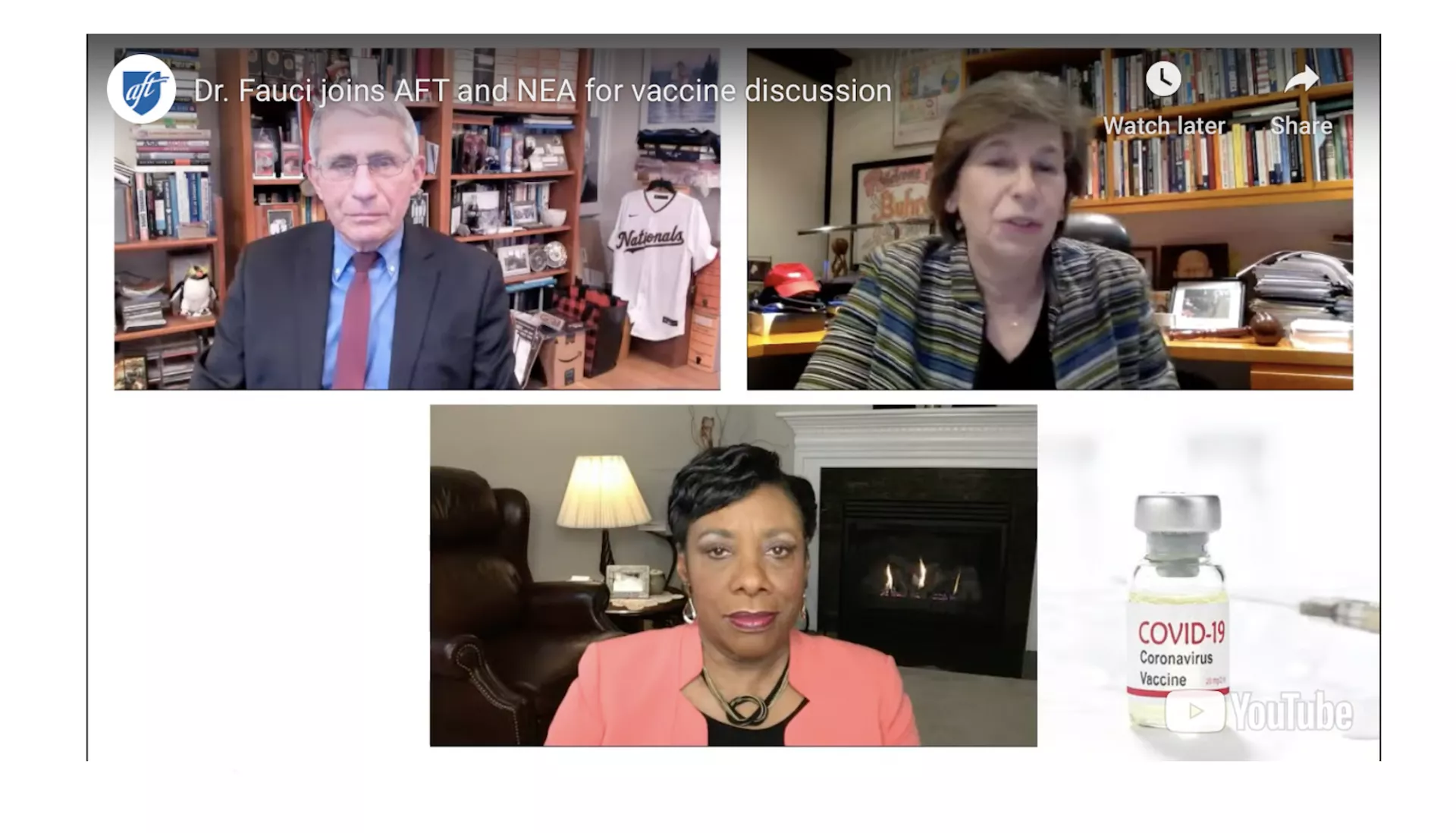Key Takeaways
- With new strains and continued spread of the virus, uniformly wearing a mask is critical.
- The new Health Equity Task Force will address racial inequities in health care during the pandemic and beyond.
- We all want our students back in school. With Biden’s American Rescue Plan, we can achieve that goal.
Educators are working tirelessly to continue instruction for our nation’s students during an unprecedented global pandemic, despite a failure by the previous administration and certain members of Congress to address the pandemic with the proven science-based guidance and resources our students, educators and families desperately need. As the pandemic continues to spread, many educators and parents, across race and place, have united to ensure a safe and healthy return to school buildings, but concerns and questions remain.
As we move toward comprehensive plans for a safe and just return to school buildings that prioritizes student, educator and family health, Becky Pringle, president of the National Education Association (NEA) and Randi Weingarten, president of the American Federation of Teachers (AFT), hosted a virtual “fireside chat” with Dr. Anthony Fauci, Director of the National Institute of Allergy and Infectious Diseases (NIAID), a member of the White House Coronavirus Task Force, as well as chief medical adviser to the Biden administration .
Members of AFT and NEA submitted thousands of questions, but given time constraints, the session covered only the most pressing questions that arose, which are included along with summations of Dr. Fauci’s answers below.
Given that the new virus strain is more easily transmitted, are there any special considerations we should take in terms of masks or other precautions?
Fauci: – The new strain is called the B.1.1.7 strain. We do not call it the U.K. strain because it adds stigma and it’s not the United Kingdom’s fault that it happened to evolve there. It is more transmissible and we have data from the U.K. that indicate that it appears to be more virulent. The strain is already in the United States -- we have over 300 cases in over 28 states. It appears that the vaccine we are using in the U.S. seems to do pretty well against it.
That is not necessarily the case with the mutant strain that is in South Africa. If you examine that strain in the test tube, it diminishes the efficacy of the vaccine induced antibodies. But that’s in the test tube. We will be finding out soon, within the next couple of days, whether or not the vaccine that we use are actually effective or not. Early indications of a trial show that the vaccine we are using is about 60 percent effective against this strain rather than 94 or 95 percent.
The bottom line is that we have to keep an eye out on this. We might have to give a boost to cover these new variants. If they are more transmissible, we need to double down on prevention modalities. That means uniformly wearing a mask, keeping a safe physical distance, avoiding congregant settings, especially indoors, and washing your hands as often as you can. The Centers for Disease Control and Prevention (CDC) has not changed any of its recommendations and is not recommending that people wear two masks or wear an N-95 mask. There is nothing wrong with wearing two masks, but there is no data that indicates that it makes a difference. They might look at accumulating data and they might change their recommendation. But now, at the minimum, always wear a mask when in congregate settings.
How can we best protect our students and school staff in face-to-face education settings?

Fauci: President Biden is taking very seriously the issue both from the students’ and the teachers’ standpoint. He believes K-8 schools need to reopen in the next 100 days. That’s the goal. It may not happen because of mitigating circumstances, but he wants to do everything in his power to get to that goal. The American Rescue Plan hopefully will provide the resources for masking, better ventilation, resources, and for whatever else is needed to protect students and schools, and to get teachers vaccinated as quickly as we can. We all want to get the children back to school, for the good of the students, for the good of the parents, and for the good of the teachers and the entire education team who work in our schools and who want as much as everybody to get children back to school.
The COVID-19 virus and all the crises it has spawned has disproportionately impacted Black, brown and Indigenous communities. Do we have the infrastructure to equitably provide the vaccines we need in these communities?
Fauci: I’m glad we can answer this question because now we do have a plan to address this issue. Part of the 101-page National Strategic Plan that President Biden announced last week at the White House includes how we must get access to health care, testing, and vaccines to communities with poor access. We have a special person, a very talented physician named Marcella Nunes- Smith, who heads the Biden administration’s Health Equity Task Force and whose role is to figure out how we’re going to do this. For example, opening up community vaccine centers, making sure we have mobile units to get to underserved areas, and to make sure we enhance the health care capability in these areas. We are acutely aware of the disparity of not only of getting infected but also of the negative consequences of getting infected that disproportionately impact underserved communities. The data are sobering, and in many respects, painful. You see a tremendous disparity in incidences of infection, hospitalizations, and deaths. We have to overcome that.
Some things we can handle right now. We can get into the community and make sure we have equity in terms of the vaccine, but if this outbreak does anything, it sheds a very bright light on the social determinants of health. When we get control of this disease, the social determinants of health will still be there, and we’ve got to make a multi-decade commitment to remove this disparity of disease, not just in terms of COVID-19, but in HIV-AIDS and all of the other underlying conditions that have always put at a disadvantage Black, brown and Indigenous communities.
In some places, school employees are getting the vaccine but not the members of their families because they do not yet qualify for vaccinations. Can someone still transmit COVID-19 even if they have been vaccinated?
Fauci: Theoretically, yes. We’re going to learn more about that and give you more of an answer soon, but the primary end point of the two vaccine trials was in preventing clinically recognizable disease, namely, preventing the symptoms associated with the infection. That’s where you got the 94 to 95 percent efficacy. What we do not yet know is if you could be infected but not know it because the vaccine is preventing you from getting symptoms. Theoretically you could be vaccinated and infected and not know it because you aren’t getting symptoms and then you could inadvertently and innocently transmit the infection by not wearing a mask. That’s why you still need to wear a mask. We will be doing quantitative studies of this and what I believe we will see is that the level of virus in people who were vaccinated but are infected without symptoms will be very low and it will be unlikely that they can transmit this disease. But until we know that, wear a mask.
More rapid testing is also needed and we need to make them available for schools. We now have a rapid antigen test, which doesn’t have the exquisite sensitivity of the classic PCR tests, but they are sensitive, especially if you use them a fair amount. They’re sensitive, they’re cheap, you can do it at home, and if you intermittently survey the students and staff, you can get a feel of the penetrance of disease.
What are the long term side effects of the vaccine?
Fauci: If you look at the history of vaccines you know that virtually all long-term adverse effects of a vaccine occur between 15 and 30 days after you get the dose, 45 days at the most. When you get a vaccine allowed by the Food and Drug Administration (FDA), such as with the emergency use authorization, you have to wait 60 days from the time half the people in the trials got their last dose and observe safety before it can be used on the public. If almost all of the long-term adverse effects occur within 45 days, you’ve gone beyond that if you wait 60 days, so the chances of there being long-term effects are vanishingly small.
Governor DeSantis of Florida is disregarding the CDC recommendations about who should be a priority for the vaccine and what the mitigation factors should be in schools. What do we do?
Fauci: That’s a tough question. I’m not sure what you can do. I don’t have any power to resolve that except to say try to have people locally do whatever they can to do the right thing in protecting their citizens.
That was the last question Dr. Fauci had time to answer in the session, but NEA president Becky Pringle asked him to share final thoughts about what we can do as educators—including everyone on the team, from teachers to food service workers to bus drivers and all school employees that Dr. Fauci says ensure our students’ wellbeing—to help President Biden get control of this virus.
Fauci: We are going through a historically challenging time with a pandemic that has taken 430,000 lives in the United States and continues to threaten to take thousands more. But we have some light at the end of the tunnel with at least two highly effective vaccines, and even more lined up that look very good. My final message, and I mean this sincerely, is that the education community is such an absolutely critical part of society in general but also are a critical response to this outbreak. We are not going to get back to normal until we can get the children back in school, for the good of the children, for the good of the parents, and for the good of the community. But we want to make sure we do that by giving them the resources they need. Saying “go do it on your own,” that doesn’t work. That’s why Biden has said the American Rescue Plan has to get through and be implemented.
So I want to close with a really big “thank you.” We have people who emerge during outbreaks as heroes. Certainly, we have the healthcare workers who are out there risking their lives, risking their safety, who are out there tirelessly working to take care of people, and they deserve all the praise in the world. But there is also the team that takes care of our students’ wellbeing, their education, and their safety, and I think that you all are a bunch of heroes as much as everyone else. Thank you very much.


